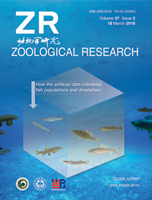
|
Zoological Research
Kunming Institute of Zoology, Chinese Academy of Sciences
ISSN: 2095-8137
Vol. 40, No. 2, 2019, pp. 121-128
|
 Bioline Code: zr19012
Bioline Code: zr19012
Full paper language: English
Document type: Report
Document available free of charge
|
|
|
Zoological Research, Vol. 40, No. 2, 2019, pp. 121-128
| en |
Home range variation of two different-sized groups of golden snub-nosed monkeys ( Rhinopithecus roxellana  ) in Shennongjia, China: implications for feeding competition ) in Shennongjia, China: implications for feeding competition
Fan, Peng-Lai; Li, Yi-Ming; Stanford, Craig B.; Li, Fang; Liu, Ze-Tian; Yang, Kai-Hua & Liu, Xue-Cong
Abstract
Knowledge on the home range size of a species or population is important for understanding its behavioral and social ecology and improving the effectiveness of conservation strategies. We studied the home range size of two different-sized groups of golden snub-nosed monkeys (Rhinopithecus roxellana) in Shennongjia, China. The larger group (236 individuals) had a home range of 22.5 km2 from September 2007 to July 2008, whereas the smaller group (62 individuals) occupied a home range of 12.4 km2 from November 2008 to July 2009. Both groups exhibited considerable seasonal variation in their home range size, which was likely due to seasonal changes in food availability and distribution. The home range in any given season (winter, spring, summer, or winter+spring+summer) of the larger group was larger than that of the smaller group. As the two groups were studied in the same area, with the confounding effects of food availability thus minimized, the positive relationship between home range size and group size suggested that scramble feeding competition increased within the larger group.
Keywords
Rhinopithecus roxellana; Home range size; Group size; Feeding competition
|
| |
© Copyright 2019 - Zoological Research
Alternative site location: http://www.zoores.ac.cn/
|
|
